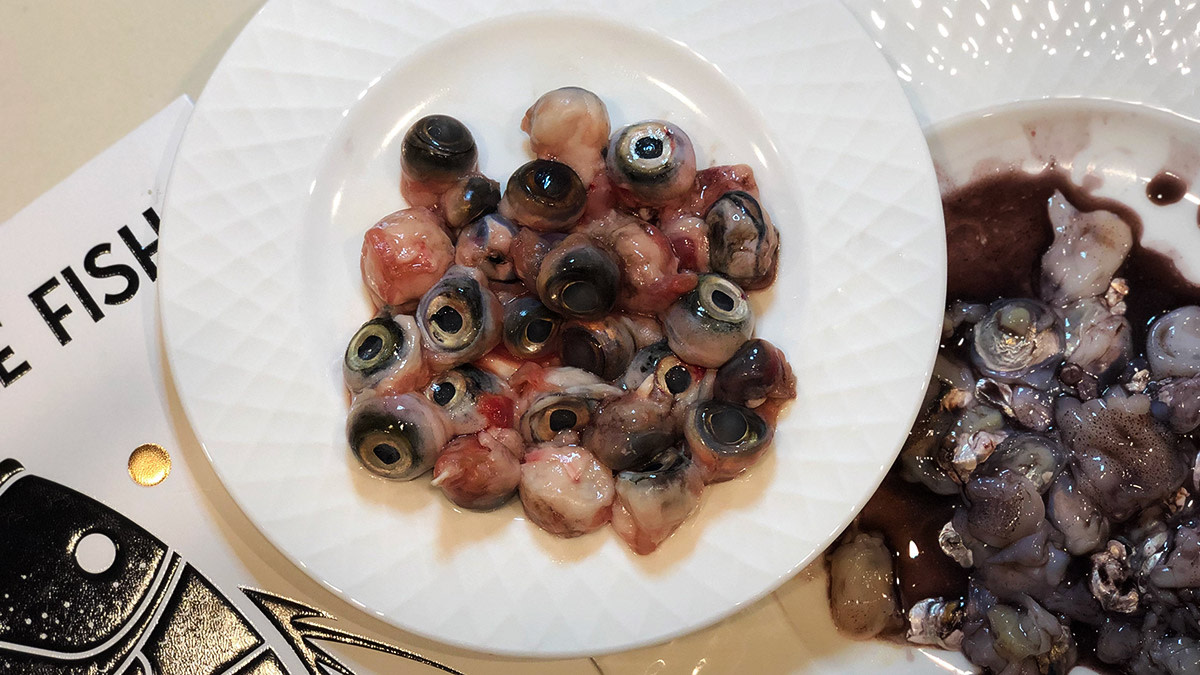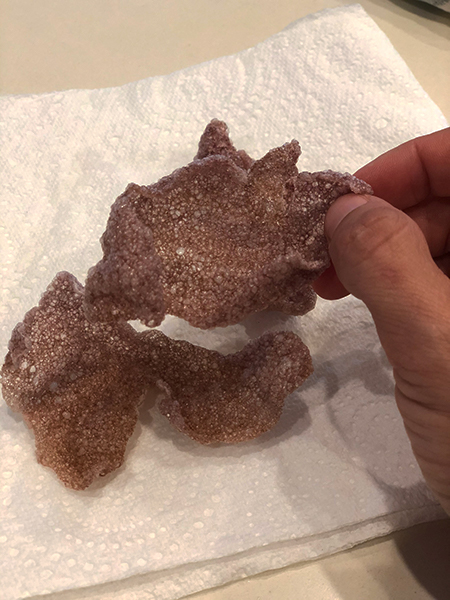
Duration
3 Hours
Serves
6-8
I can count exactly zero times when I’ve thought, “You know what sounds good right now? A meal of eyeballs!”
My lack of enthusiasm for these slimy snacks isn’t unique. Eating eyeballs puts many meateaters on the fence. For some adventurous chefs, it’s a comforting reminder that they’re using the whole fish, while others simply can’t get past the eyeball’s gelatinous texture and chilling gaze.
Despite our modern squeamishness, people have been eating fish eyeballs forever. The eyes sit on a layer of fatty tissue that’s nutritious and actually quite tasty. It’s good on its own, but also takes on other flavours when cooked as part of the entire fish head. Chefs use eyeballs to add flavour and texture to recipes; some even use pureed eyeballs as a thickening agent for stews and sauces.
At this point, I’ve eaten my share of eyeballs and can say without hesitation that they’re delicious. That said, they do have a small, chalky ball at their centre, so my advice is to eat them like an olive and treat the core like a pit. They can also be used in many recipes that don’t require eye contact with your food.
For this installment of Nostril to Caudal, I chose to make Josh Niland’s fish eye chips from his “The Whole Fish Cookbook.” The chip is basically a prawn cracker that substitutes fish eyes for prawn. Eyeballs should always be as fresh as possible and should look healthy, clear, and bulbous.
Ingredients
- 5 oz. fresh fish eyes
- 3.5 oz. calamari eyes
- 1 cup tapioca flour
- Vegetable oil for deep frying
Also works with
Special equipment
Blender
Bamboo Steaming Plate
Dehydrator
Preparation
Initially I was unsure how to extract the eyes from the squid. They gushed a metallic lava when I tried popping them out, and black dye squirted all over my hands and countertop. I decided to use scissors to cut out the eyes and the bits of meat they were attached to.
Niland says to blend all of the eyes until they transform into a runny, grey liquid and then to pour them into a fine sieve. Add water as needed to reach the desired consistency.
I used a spatula to push any remaining liquid from the mixture and then discarded the leftover chunks.
Using a spatula to mix in the tapioca flour, I stirred until the batter took on the consistency of thick cream. Then I spread the mixture onto a paper-lined bamboo steamer as thin as possible before steaming it for 10 minutes over a pot of boiling water. Finally, I placed the steamed patties into my dehydrator and waited for them to dry out (you can also use an open propped open, set at its lowest temperature).
Once dehydrated, you can store the sheets until you’re ready to use them. When that time comes, heat your oil to 375 in a frying pan, then break a piece off the sheet and drop it into the hot oil for ten seconds. I used a probe thermometer to ensure the oil hit 375 degrees, as I found these chips absorbed too much oil if it wasn’t quite hot enough. In the oil the chip will immediately begin to puff into its own unique shape. Remove the chip and set it on a paper towel to cool.
After some trial and error, I’ve come to realize that this gorgeous cracker is perfect for dipping and garnishing, as a standalone snack, or crumbled topping. It also just so happens to be a damn good conversation piece. Enjoy, and stay tuned for the next installment of Nostril to Caudal where we explore the fish’s body cavity!
Sign In or Create a Free Account
Reviews
I can count exactly zero times when I’ve thought, “You know what sounds good right now? A meal of eyeballs!”
My lack of enthusiasm for these slimy snacks isn’t unique. Eating eyeballs puts many meateaters on the fence. For some adventurous chefs, it’s a comforting reminder that they’re using the whole fish, while others simply can’t get past the eyeball’s gelatinous texture and chilling gaze.
Despite our modern squeamishness, people have been eating fish eyeballs forever. The eyes sit on a layer of fatty tissue that’s nutritious and actually quite tasty. It’s good on its own, but also takes on other flavours when cooked as part of the entire fish head. Chefs use eyeballs to add flavour and texture to recipes; some even use pureed eyeballs as a thickening agent for stews and sauces.
At this point, I’ve eaten my share of eyeballs and can say without hesitation that they’re delicious. That said, they do have a small, chalky ball at their centre, so my advice is to eat them like an olive and treat the core like a pit. They can also be used in many recipes that don’t require eye contact with your food.
For this installment of Nostril to Caudal, I chose to make Josh Niland’s fish eye chips from his “The Whole Fish Cookbook.” The chip is basically a prawn cracker that substitutes fish eyes for prawn. Eyeballs should always be as fresh as possible and should look healthy, clear, and bulbous.
Ingredients
- 5 oz. fresh fish eyes
- 3.5 oz. calamari eyes
- 1 cup tapioca flour
- Vegetable oil for deep frying
Also works with
Special equipment
Blender
Bamboo Steaming Plate
Dehydrator
Preparation
Initially I was unsure how to extract the eyes from the squid. They gushed a metallic lava when I tried popping them out, and black dye squirted all over my hands and countertop. I decided to use scissors to cut out the eyes and the bits of meat they were attached to.
Niland says to blend all of the eyes until they transform into a runny, grey liquid and then to pour them into a fine sieve. Add water as needed to reach the desired consistency.
I used a spatula to push any remaining liquid from the mixture and then discarded the leftover chunks.
Using a spatula to mix in the tapioca flour, I stirred until the batter took on the consistency of thick cream. Then I spread the mixture onto a paper-lined bamboo steamer as thin as possible before steaming it for 10 minutes over a pot of boiling water. Finally, I placed the steamed patties into my dehydrator and waited for them to dry out (you can also use an open propped open, set at its lowest temperature).
Once dehydrated, you can store the sheets until you’re ready to use them. When that time comes, heat your oil to 375 in a frying pan, then break a piece off the sheet and drop it into the hot oil for ten seconds. I used a probe thermometer to ensure the oil hit 375 degrees, as I found these chips absorbed too much oil if it wasn’t quite hot enough. In the oil the chip will immediately begin to puff into its own unique shape. Remove the chip and set it on a paper towel to cool.
After some trial and error, I’ve come to realize that this gorgeous cracker is perfect for dipping and garnishing, as a standalone snack, or crumbled topping. It also just so happens to be a damn good conversation piece. Enjoy, and stay tuned for the next installment of Nostril to Caudal where we explore the fish’s body cavity!





